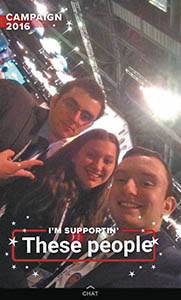
During the AIPAC (American Israel Public Affairs Committee) 2016 Policy Conference, there was an area called the AIPAC Village, a collection of booths manned by Israeli and American companies, as well as a bunch of exclusive clubs and food stands. I came across a booth showing a virtual reality headset, the Gear VR, running a program that allowed people to virtually travel to Jerusalem. After trying it out for a few minutes, I asked a woman running the booth what was the Israeli connection to the Gear VR headset itself. I knew its maker, Oculus, is an American company—but perhaps the technology was developed originally in Israel? I was hoping that the technology was some sort of unique Israeli innovation that would exemplify the “start-up nation.”
Her response: the software, with the tour de Jerusalem, was made in Israel, but the headset was fully American.
At first I felt a bit disappointed. After all, it would have been so cool if the VR headset was through and through Israeli! But then, thinking about it, I realized that what the VR headset and software together represented was significant in and of itself. It represented the fusion of American and Israeli work, where an American innovation was iterated on and improved in Israel—a true partnership between the two countries and allies. That, to me, is a microcosm of what the entire AIPAC Policy Conference showcased.
I’ve known about AIPAC as an organization for a long time, and had seen pictures and clips from its annual policy conference. But this year was the first year I was able to actually attend, thanks to the generosity of the Ramaz Upper School and Congregation Kehilath Jeshurun. I had somewhat of an idea of what to expect at the AIPAC 2016 Policy Conference: a lot of speeches, massive general sessions, smaller classes on focused issues (I had signed up for them in advance), and likely half of the Jewish world in attendance! But I wondered how it was all going to be in person, in the flesh.
My delegation, consisting of a handful of my classmates and a faculty advisor, left early on Sunday morning to make the journey from New York to Washington, D.C. We arrived a bit later than we expected, and I was only able to make it to the tail end of my first small breakout class, which was about Palestinian public opinion regarding Israel and their leadership. I’m not going to speak about the specifics of the session itself, as it was off the record and closed to the press (like many AIPAC sessions), but it gave me a taste of what to expect at the AIPAC breakout sessions. These sessions featured a table of panelists, discussed a difficult topic in depth, and weren’t afraid to delve into tricky topics. One session, for instance, discussed the nuances of the Syrian refugee crisis, delving into opinions that disturbed me but that I appreciated getting a chance to hear.
Later on there were the general sessions, which took place in the massive Verizon Center. Our seats were all the way in the nosebleed section, but we still had a full view of the AIPAC stage. The general sessions, which addressed the entire population in attendance, lacked the nuance and in-depth discussions of the smaller breakout sessions, but made up for it in sheer spectacle, excitement and star power. The crowd was constantly cheering, the speakers captivated the audiences for the most part, and political celebrities—Joe Biden, most of the current presidential candidates, Paul Ryan, and others—reaffirmed their support for Israel.
Over the course of the general sessions, I realized how AIPAC was different than other pro-Israel organizations I had encountered before, and how Policy Conference was far different than other pro-Israel events I had gone to before: it was about both America and Israel, about the relationship between the two countries. This made sense; AIPAC is partially about lobbying government members and convincing them to support pro-Israel legislation (sadly I missed the third day of the conference, which was the day of lobbying). But it didn’t hit me until I started seeing both Israeli and American politicians talking about the two countries; until the conference attendees sung both countries’ anthems; until I perused the Israeli and American innovations at the AIPAC Village. It made me appreciate how the two countries work together, in fields of innovation, security and far more.
I’m not going to claim that everything at the conference was perfect. Sometimes it felt as if the various speakers during the general sessions were rehashing the same ideas over and over. A friend and I had a fake drinking game for each time someone referenced “bipartisanship”! Also, and of course this is superficial: the food was overpriced to the point of absurdity (the chicken nuggets averaged out to $3 a nugget). But flaws aside, being at the AIPAC Policy Conference was not only an inspiring experience for me, but also a unique one. I learned to appreciate not only the state of Israel, but the relationship between the United States and Israel. I was not only proud to be a supporter of Israel, but also to be an American.
(I’ve barely scratched the surface of what I experienced at the conference, so expect another article or two on AIPAC to come!)
By Oren Oppenheim
Oren Oppenheim is a sleep deprived child who will do more Israel advocacy after getting some shut eye.










